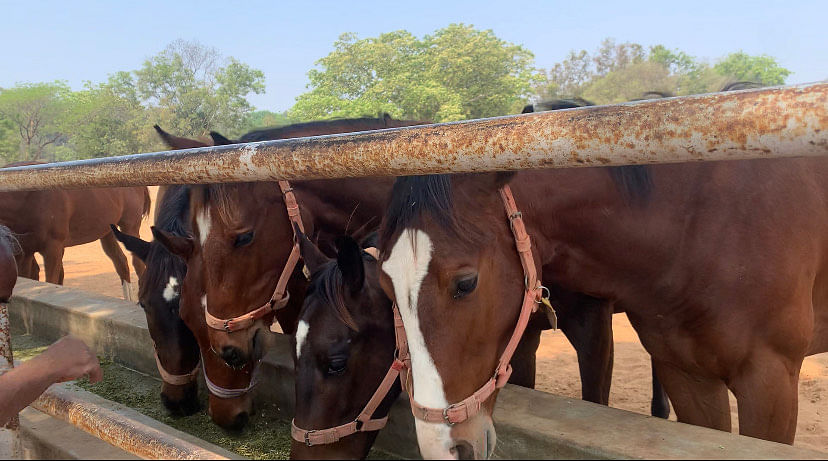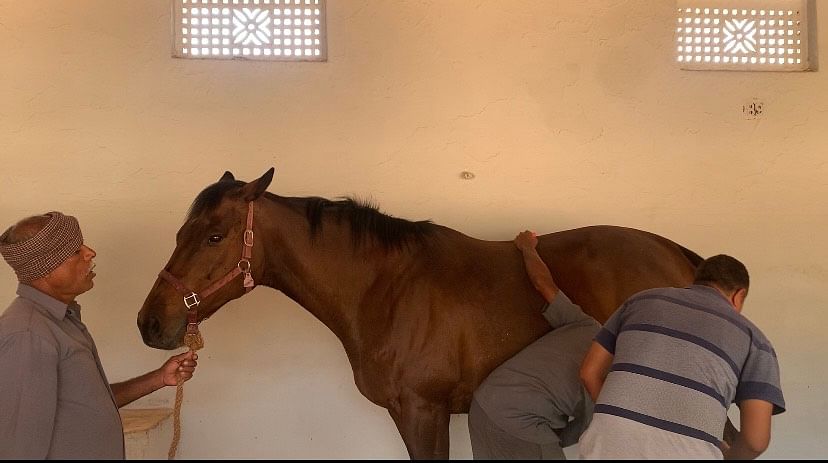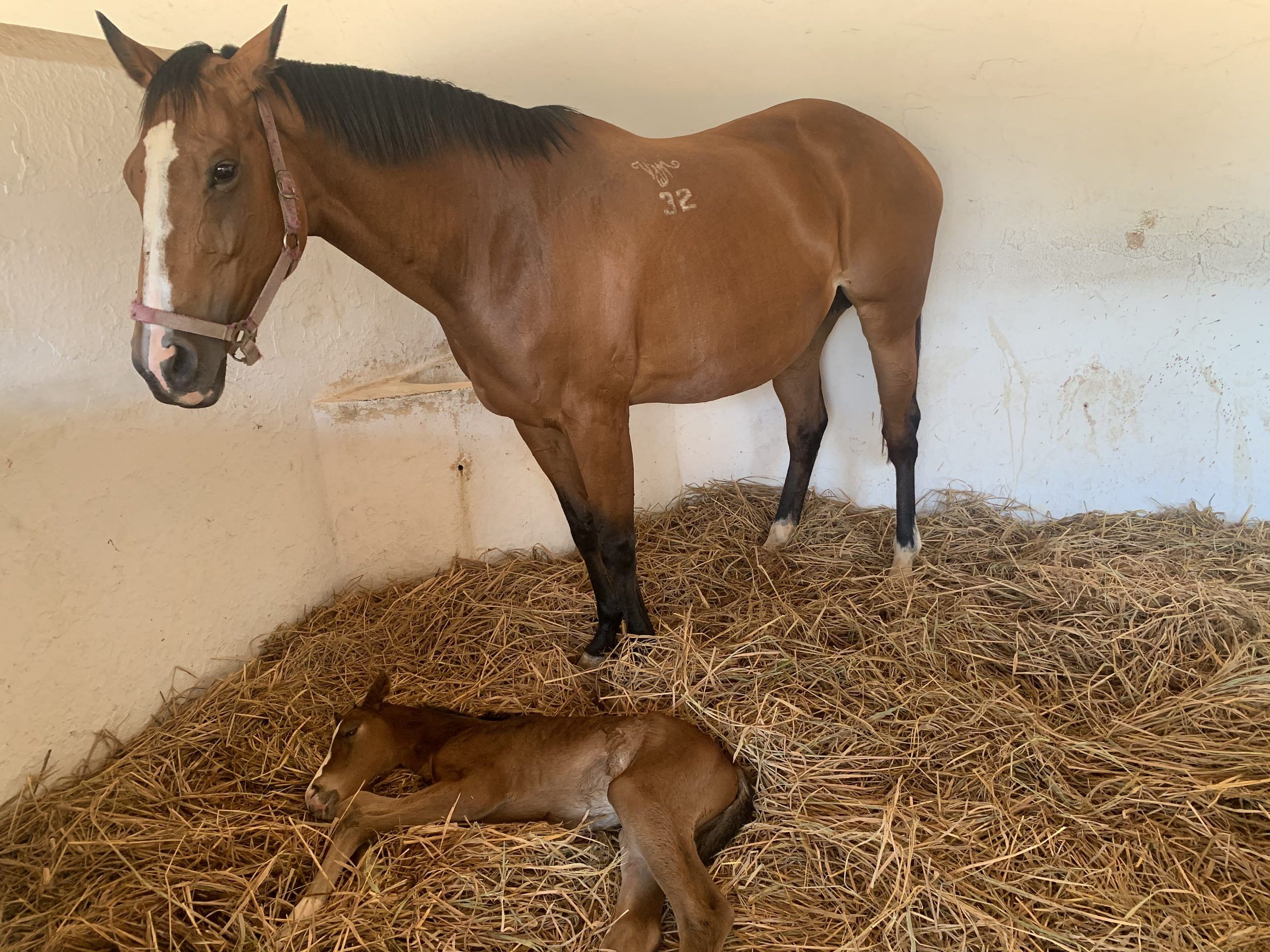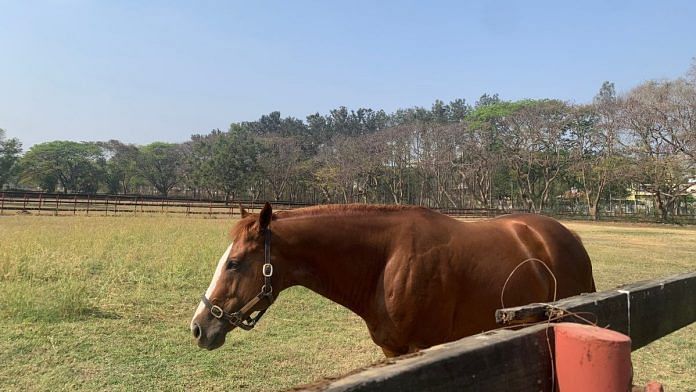Bengaluru: Baratti’s chestnut-brown coat glistens in the sun as he canters aimlessly, occasionally pausing to bask in its warmth. Imported from Ireland, he’s a retired racehorse now living in Kunigal, a stud farm 70 kilometres away from Bengaluru. But the stallion’s post-retirement life, in verdant green fields and a stable overlooking a bougainvillea-trimmed bush, is in question.
The Karnataka government wants its land back to convert Kunigal Stud Farm into an ‘integrated township’ to unclog Bengaluru. This ambitious plan has stirred up a frenzy. Battle lines have been drawn. On one side is the construction boom and the fight for land, propelled by an urgent need to decongest the metropolis. On the other side is the preservation of green spaces—ancient trees, biodiversity—and of memory, prestige, and heritage. There have been two protests over the past two months, with plans underway to move the court. The government hasn’t announced its future plans, but residents of Kunigal are chomping at the bit to take to the streets again, if need be.
Kunigal, Karnataka’s last stud farm, evokes nostalgia for a Bengaluru that is fast becoming a memory. Once the city of lakes, parks and retirement homes is now besieged by one crisis after another. Where there were lakes, there is now water scarcity. Where there were roads, there are now potholes. And where there were green corridors, there are now traffic jams. In the tug-of-war between development and green lungs, the 420-acre stud farm may join the long list of open spaces in and around the city that have been sacrificed at Bengaluru’s altar.
Kunigal’s impending fate is an example of what’s happening in other corners of the country as well, part of a more widespread trend. Mumbai’s iconic Mahalaxmi Racecourse is set to become Mumbai’s Central Park.
In 1992, the Karnataka government leased the land to Vijay Mallya’s company for 30 years. India’s biggest horse patron Villoo Poonawalla was supposed to take over in 2022, but the Congress government not only cancelled the tender but has aslo announced to convert the land into an integrated township.
The long and storied history of the stud farm precedes the establishment of Kunigal town itself. In 1792, Tipu Sultan bred warhorses in Kunigal, preparing them as part of his cavalry forces. Fast forward a couple of centuries, and the stud farm has become yet another point of contention, presenting a roadblock in Bengaluru’s quest to forge a new urban identity amid rapid development and growth.
“It’s the loveliest location, ideal for breeding,” says Zeyn Mirza, managing director of United Racing and Bloodstock Breeders Ltd, the company overseeing the racing activities of fugitive businessman and horse aficionado, Vijay Mallya. In 1992, the Karnataka government leased the land to Mallya’s United Breeders for 30 years. Since the expiration of the tender in 2022, however, the Kunigal Stud Farm has been operating in a state of restless uncertainty.

“We don’t know what will happen to the horses. But it will be our problem. I am trying not to think that far ahead. I’m being hopeful and positive,” says Mirza.
The land was due to be leased out to the highest bidder—Villoo Poonawalla, India’s biggest horse patron. But once Bavasaraj Bommai’s BJP government made its exit, cabinet approval never came.
Instead, Urban Development Minister Byrathi Suresh put out a tweet in December, announcing plans to convert the stud farm into an integrated township.
“If the farm isn’t there, Kunigal loses its identity,” says Shankarappa, a caretaker at the farm for the last 32 years.
“That’s when it all started, with the tweet,” says Ram Prasad, another director at United Racing. In the growing groundswell of support for the farm, as ‘Save Kunigal’ became the rallying cry, even senior ministers are cautious. Karnataka Chief Minister Siddaramaiah redirected questions back to Suresh, and instead brought up a proposal to give 100 acres of the Kunigal Stud Farm land to the Bangalore Turf Club.
It’s yet to be determined when and how the township, which will supposedly have “everything”, will be implemented. There are no exact plans on the turf club as well.
“If the farm isn’t there, Kunigal loses its identity,” says Shankarappa, a caretaker at the farm for the last 32 years.
Stud farm vs township project
An entire world exists within Kunigal, shaped by the labour of local people and genuine affection for the horses. Around 6,500 trees, some of them hundreds of years old, also stand in the government’s proposed township project.
“Kunigal is in the pipeline because talent is available in Bengaluru, and people can move there. It makes sense geographically. With the township, people need not enter Bengaluru at all,” says Rakesh Singh, additional chief secretary in the Urban Development Department and chairperson of the Bangalore Development Authority, envisioning an almost utopian future.
Though development is considered a life-raft for Bengaluru, citizens of Kunigal, ecologists and well-wishers of the stud farm question the need to convert land that’s already in use.

“There’s about 800 acres of land outside the stud farm…why can’t that be used?” Ram Prasad wonders aloud.
According to officials in the Urban Development Department, it’s the location. Bengaluru is currently in the throes of a massive water crisis, a testament to the poor management of its lakes. The stud farm is located opposite the 2 km-long Kunigal Lake, so there’s ample water supply.
“Kunigal is in the pipeline because talent is available in Bengaluru, and people can move there. It makes sense geographically. With the township, people need not enter Bengaluru at all,” says Rakesh Singh, additional chief secretary in the Urban Development Department and chairperson of the Bangalore Development Authority
“Whenever a township is conceptualised, there are three necessary criteria: available land, ensured water supply, and accessibility. We have a few locations in mind [other than Kunigal], but these things take time. If there’s no accessibility, people will not come,” says Singh.
The Urban Development Department isn’t too fussed by the protests.
“We are a great democracy, we oppose everything. Whenever there is such a case, there are those who are for it and those who are against it,” said an official nonchalantly. He acknowledges that the opposition from Kunigal’s residents has merit, but argues that it is for the larger interest of society. It’s a tussle that will inevitably continue, he explains.
“But if we kept talking about ecology and biodiversity, how would civilisation have come into being? There needs to be a balance between ecological survival and development,” the official added.
The priority is to save Bengaluru from its traffic, poor infrastructure, and water crisis. Karnataka, in its search to build another Bengaluru, is no stranger to ambitious township plans—and protests.
In 2022, the government had identified seven districts for industrial townships. These included land parcels in Chikballapur, Belagavi, Chitradurga, and Kolar. The 2022-23 state budget called for planned townships that would herald “New Karnataka for New India’.
The previous year, the BJP government put forth its vision to build a township at Kolar Gold Fields (KGF), and conducted a survey on 3,213 acres of “unused” land. The site was chosen for its proximity to Bengaluru-Chennai industrial corridor, and it was expected that industries would be incentivised to “set up shop”. The once-thriving gold mining town is also not too far from Kempegowda International Airport.
None of the townships has materialised so far, and there are fears that once Baratti and the other racehorses are relocated and the trees chopped, Kunigal Stud Farm will meet a similar fate.
The plan to convert KGF into a township to ease the strain on Bengaluru goes back to 2017.
“We want to develop a state-of-the-art township, which grows into a counter magnet to Bengaluru,” then-Urban Development Minister Roshan Baig had said at the time. If South Korea could build the future-oriented Songdo city from scratch, then why not Karnataka. “Quite a few countries have built modern cities in what was once a mining area. Songdo was a mining region,” Baig had argued.
But none of the townships has materialised so far, and there are fears that once Baratti and the other racehorses are relocated and the trees chopped, Kunigal Stud Farm will meet a similar fate.
A movement has gathered steam
The “save Kunigal” movement has witnessed protest marches with hundreds of participants. The residents held up placards, shouted slogans, and marched alongside horses decked up and walking soberly.
“The entire district has come together, and is now protesting against the township proposal. They want to build for the rich and we are opposed to it,” says Naganna GK, a Kunigal native. He claims that the 17 January protest saw the participation of over 4,000 people.
“Destroying the horses’ habitat doesn’t bode well with our culture.”
The Kunigal Stud Farm essentially exists for livestock breeding, and the approximately 200 people employed there possess a specialised skill-set, adept at gauging horses’ behaviour and monitoring their mating patterns.
“We take care of the horses just like we take care of our cows and buffaloes at home,” says the caretaker Shankarappa, as he goes on to feed Roderic O’Connor, a dark-brown stallion. Currently, salaries are being paid, and on the surface, it appears to be business-as-usual, but there’s a heightened sense of anxiety.
“All we’re doing is animal husbandry. We’re providing employment to local people, not causing any disturbance. Why wouldn’t the government want to continue these heritage activities and preserve them for future generations?” asks Dr Dinesh, the senior manager and vet at Kunigal.
He drives through the estate in a jeep, acutely aware of every detail––where the roads curve, which mare is how many months pregnant.
There’s a foal that was born this morning, lying down in its stable while its mother, a former racehorse weighing 500 kg, stands over it. “Come here boy,” he calls out to Baratti, and the stallion nods his assent. He has worked at the farm for the last three decades, living in its vicinity, even as his children attend school in Bengaluru.

But apart from heritage, it’s the ecological diversity of the stud farm that people are keen to fight for. According to Dr Dinesh, even if just the turf club were to be brought within the confines of the stud farm, about 2,000 trees would have to be cut down. A racetrack and stands will have to be set up, among other things.
Vijay Nishanth, a “tree-doctor”, has joined the cause. He wants to conduct a tree census of the area—counting the exact number of trees, capturing the variances, as well as their ages. It’ll be a database of sorts, available online and built to help local people and outsiders access Kunigal—turning it into a tourist attraction or a “picnic spot”.
But the public consensus is that the stud farm is more than just a tract of land or a repository of water. It’s a piece of heritage. Mirza opens his laptop and reads out an email he received a few days ago. It’s from a group of eight women keen on visiting the stud farm.
“We want it to be open to outsiders, and we are more than happy for people to come, visit, and understand what we do,” he says.
‘Glory days’ under Vijay Mallya
About 15 years ago, there were 17 stud farms in and around Bengaluru. Today, only Kunigal remains. It’s adored by Vijay Mallya, who saw it through its prime.
“It’s a lovely area, a lovely property, and also just to be amongst horses,” Mallya said in a 2016 video, the year before he fled to London. He also spoke about “a lot of luck” he had with the fillies raised in Kunigal, as well as his enduring passion for horses.
The stud farm was in a state of relative disarray, when the Karnataka government leased it to him in 1992. It wasn’t ranked among the country’s top stud farms and the horses weren’t performing particularly well. In 2003, Mallya convinced Mirza to return from London and oversee operations at Kunigal, which was ranked 11 in India at the time. Mirza bought fresh stock, and introduced big management and administrative changes.
“Our glory years were from 2006 till about 2021,” says Mirza. “Then we started dipping again.”
Vijay Mallya had 100 racehorses at Kunigal. Today, all of them have been sold—including Desert God, who secured his owner Rs 8 crore in winnings. Kunigal’s yearly turnover is about Rs 12 crore, which is not enough to sustain the estate.
Mallya had 100 racehorses at Kunigal. Today, all of them have been sold—including Desert God, who secured his owner Rs 8 crore in winnings. Kunigal’s yearly turnover is about Rs 12 crore, not enough to sustain the estate. However, according to the Indian Stud Book, it’s still the country’s third best.
Currently, there are 65 mares, three stallions, and 70 yearlings at Kunigal.
By Bengaluru standards, it’s currently scorching. The green grass is a pallid brown, and the trees are more or less bare. There’s a wooden house on stilts that stands empty, save for a couple of workers. Its former splendour and past riches are everywhere, in the framed photographs of prize-winning horses, silver trophies, and euphoric smiles.
The Mirzas’—generations of horsemen
The genteel decay of Kunigal Stud Farm is a fading chapter in Bengaluru’s horse racing and breeding history. Punters, the gloriously old-fashioned names given to horses, floaty hats worn to the races, and its supposedly “elite” character. Put Bangalore Turf Club’s crisis into the mix, and it’s all dwindling.
Mirza has seen it firsthand––the highs and lows of the industry somewhere mirror those of his family. “It’s in our blood I suppose,” he says.
Five generations of his family have made their living through horses. He is following in the footsteps laid out hundreds of years ago. His ancestor, Agha Aly Asker, travelled from Iran—with 200 horses in tow. Sandwiched between Cunningham Road and Infantry Road is the more unobtrusive Ali Asker Road. Asker started trading horses, and somewhere along the line, the animal seeped in.
Mirza’s father, Fouad, was commandant of the President’s Bodyguard, and member of the Indian polo team. His nephew is an equestrian champion, currently preparing for the Paris Olympics. His grandfather’s elder brother was the Dewan of Mysore.
The Mirzas used to operate their own stud farm—from 1979 until 2005, when it became another victim of urban development. It got too expensive to maintain, owing to its prime location—close to the airport. And bit by bit, in tiny increments, the Mirzas sold their horses and let go of what represented family passion. However, there’s no bitterness.
“We can’t dwell on the past,” says Mirza.
Horses aren’t a strategic investment. Prices are high and the returns dubious. “Breed the best with the best and hope for the best,” declares Mirza. There’s always the risk of another Snaafi Dancer, a thoroughbred bought for over $10 million in the 1980s. He didn’t win a single race, despite his immaculate breeding. Then, he also turned out to be infertile—and couldn’t yield any racehorses of his own.
On average, according to Dr Dinesh, a horse at Kunigal currently costs about Rs 20 lakh. It’s Rs 20 lakh for what can only be a passion. Punting is also categorised as gambling, and as of last year, attracted a GST of 28 per cent. This means the prize money, the sum received when the horse you bet on wins, is far lower than what it used to be. What used to be Rs 1 crore is now Rs 65 lakh.
A horse at Kunigal on average costs about Rs 20 lakh. And because of the 28 per cent GST, the prize—the sum received when the horse you bet on wins—has come down from Rs 1 crore to Rs 65 lakh.
There’s no ‘glamour’ at Kunigal, none of Mallya’s flamboyance. But there is Baratti, winner of the Prix Lord Seymour, the Prix De Mours, to name a few; his name carved into his bridle—but its days of racing glory are over. “He’s a sensational stallion; it’s like when a child succeeds,” says Mirza with pride.
He and Nishanth sit in his office on Bengaluru’s Cunningham Road, brainstorming about what comes next. Nishanth has been consulting a lawyer, and a Public Interest Litigation is in the works.
“We just have to dig out more and more. Our understanding of Kunigal should be crystal clear,” says Nishanth. “We need to do our homework.”
Nishanth recalls being at the Nuwara Eliya Racecourse a few months ago, now Sri Lanka’s only race course, and Kunigal coming up in conversation. It’s an example of the stud farm’s global prestige, the importance it carries even outside India. A number of horses were transferred from Kunigal to Nuwara Eliya. It occupies a unique space, even among the global community, and there’s a treasure trove of history available.
Together, the two men are scanning the archives for information on Kunigal’s heritage and collating data on its ecological value—mining the stud farm for all its worth.
“Every inch can be accounted for,” says Mirza.
(Edited by Prashant)



